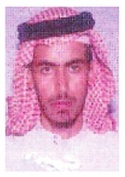 |
|
Saleh Abd al Aziz Hamad al Luhayb. Image from Saudi Arabia’s Ministry of the Interior. |
Coalition and Afghan forces killed two “Arab”-linked insurgent commanders, a wanted Saudi and an Afghan, during two separate raids in the Waygal district of Nuristan province over the past week. The International Security Assistance Force is not linking commanders identified as having “Arab involvement” to al Qaeda or affiliated groups despite the fact that Saudis holding top al Qaeda leadership positions have been known to operate in Afghanistan.
Saleh Abd al Aziz Hamad al Luhayb, who was also known as Abu Sulayman and Salman, was killed in the first raid, which occurred on May 1. ISAF originally identified him as a “senior insurgent leader,” a “known mortar and explosives expert,” and a “key liaison and trainer to local insurgent commanders in Waygal district. Al Luhayb “led efforts to establish a permanent foreign fighter presence in the area,” ISAF continued.
The term “foreign fighters” is defined by the US Department of Defense as “those fighters who have travelled to Afghanistan from outside the Afghanistan/Pakistan region,” according to its December 2012 report on Afghanistan.
Al Luhayb was a “Saudi/Arab” who was affiliated with “foreign terrorists,” ISAF later told The Long War Journal. But ISAF refused to identify al Luhayb as a member of or affiliated with al Qaeda. Instead, ISAF would only say “there are indications of Arab involvement.”
When asked by The Long War Journal if “indications of Arab involvement” is a reference to al Qaeda, ISAF responded that “saying ‘there are indications of Arab involvement’ is as specific as we can get at this time.”
Luhayb was listed by Saudi Arabia’s Interior Ministry as one of the 47 most wanted terrorists in 2011, which is a strong indication that he was a member of al Qaeda. Some of al Qaeda’s top leaders are on Saudi Arabia’s wanted lists [see LWJ report, Saudi Arabia names 47 most-wanted terrorists].
Saudis are known to hold top leadership positions within al Qaeda’s network, and are also known to operate in neighboring Kunar province. ISAF has killed several top Saudi al Qaeda leaders in Kunar. Al Qaeda’s leader in Kunar and Nuristan province has been identified as Farouq al Qahtani, a Saudi citizen. Another senior al Qaeda leader known to operate in Kunar is Azzam Abdullah Zureik Al Maulid Al Subhi, a Saudi who is better known as Mansur al Harbi [see LWJ reports, Senior al Qaeda leader, facilitator killed in airstrike in Kunar and ISAF captures al Qaeda’s top Kunar commander].
Al Luhayb’s death was first reported in the Afghan press on May 1. The governor of Nuristan told TOLOnews that an “Arab” fighter was killed in a NATO drone strike; the name of the Arab who was killed was not given, however.
When The Long War Journal inquired with ISAF about the reported drone strike that killed an Arab, ISAF denied that such an attack took place.
After ISAF reported al Luhayb’s death in a press release, The Long War Journal inquired if he was killed in an airstrike or a ground raid. ISAF responded that “due to operational security we do not discuss our tactics and cannot detail the type of operation it was.” However, in the past, ISAF has provided specific details of raids against insurgent targets in numerous press releases.
“Arab”-linked Afghan insurgent commander killed the next day
The second “Arab”-linked commander was killed in the Waygal district just one day later. ISAF identified the commander as Mohammad Issa, who was also known as Emirati. Issa was “a senior leader with ties to the Taliban and other terrorist networks” and was “in charge of training Taliban fighters and leaders responsible for attacks against Afghan and Coalition forces.”
In addition to training and leading fighters, Issa “had a history of hosting transitory international terrorist in his home prior to them engaging in terrorist activities.”
ISAF told The Long War Journal that Issa was an Afghan national and, like al Luhayb, “there are indications of Arab involvement.”
ISAF obscuring links to al Qaeda
One other time this week, ISAF mentioned that it targeted an insurgent commander with links to Arabs. Prior to this week, however, ISAF has not used this terminology to describe leaders linked to the activities of foreign fighters.
On May 1, a “senior insurgent leader” with links to the Movement of the Taliban in Pakistan, the Haqqani Network, and Arabs operating in the eastern Afghan province of Nangarhar was the focus of a joint raid by Afghan and Coalition forces. The leader also commands suicide bombers and runs a training camp in an undisclosed location along the Afghan-Pakistan border. ISAF told The Long War Journal that the commander is an Afghan and is associated with “Arab involvement.”
ISAF has not mentioned a raid against al Qaeda’s network in Afghanistan since Jan. 24, when it announced that Wali, an al Qaeda-associated Taliban leader, was killed during an operation in Dangam district in Kunar province. Wali served as both an al Qaeda facilitator and a Taliban commander; he coordinated operations between the two groups.
The only other reported raid against al Qaeda’s network this year took place on Jan. 23, in the Ghaziabad district in Kunar. ISAF has reported on raids this year against al Qaeda-affiliated groups, however, such as the Islamic Movement of Uzbekistan, the Lashkar-e-Taiba, and the Movement of the Taliban in Pakistan.
In April, The Long War Journal identified the trend toward a lack of reporting on operations against al Qaeda and requested that ISAF discuss the terror group and its network in Afghanistan. A senior ISAF public affairs official said that ISAF “won’t be able to support your request regarding the presence” of al Qaeda [see LWJ report, ISAF operations against IMU in 2013 at highest rate since war’s start].
Most US military and intelligence officials contacted by The Long War Journal were reluctant to discuss ISAF’s current policy on discussing al Qaeda. But one senior official described the military command’s position as “pure dissimulation on the part of ISAF.”
The official said that senior officers at ISAF are uncomfortable with the fact that al Qaeda has maintained safe havens in the northeastern provinces of Kunar and Nuristan after US forces withdrew from large areas of the provinces in 2009 and 2010 as part of the military’s population-centric counterinsurgency strategy. US forces pulled out of remote locations in the two provinces even as ISAF was reporting that al Qaeda was running training camps there [see LWJ report, ISAF captures al Qaeda’s top Kunar commander].
“This is everything to do with IJC [ISAF Joint Command] not wanting to publicly admit that there is an al Qaeda sanctuary in Kunar-Nuristan, even though the official Pentagon reports on the topic admit as much,” the official said, referring to the April 2012 and December 2012 releases of the biannual Report on Progress Toward Security and Stability in Afghanistan. The April 2012 report specifically mentioned that al Qaeda is trying to maintain safe haven in Kunar and Nuristan, while the December 2012 report more generally mentioned “the northeastern region” of Afghanistan. Additionally, a classified US military assessment based on prisoner interrogations that was leaked to The New York Times in February 2012 said that al Qaeda maintains “a small haven” in Kunar and Nuristan.
The official also said that Arabs in these areas are either members of al Qaeda or affiliated with the global terror group.
“Arab involvement doesn’t always mean AQ [al Qaeda], but it does mean AQ affiliated,” the official stated. “Sometimes Arab fighters belong to other groups, but all of those fighters are part of or closely affiliated with AQ.”
“We do not want to admit this outside of the throwaway lines about al Qaeda having a safe haven in Kunar-Nuristan because to do so would place a whole host of decisions including the original withdrawal from Kunar-Nuristan in doubt and allow for the failure of our most bare bones remaining objective in Afghanistan,” the official concluded.


